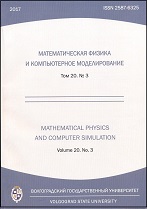|
Mathematics and mechanics
Spectral analysis of an integro-differential operator with a degenerate kernel
A. N. Shelkovoy
Voronezh State Technical University
Abstract:
We consider operator $\mathcal{L}$ acting in the Hilbert space $L_2[0,1]$ defined by the integro-differential expression $(\mathcal{L}x)(t)=-\ddot {x}(t)-\int\limits_{0}^{1}K(t, s)x(s)ds$ with the domain $D(\mathcal{L}) = \{x\in W_2^2[0,1], ~ x(0) = x(1) = 0\}$, where $W_2^2[0,1]$ is the Sobolev space
$\{x\in L_2[0,1] :x'$ is absolutely continuous, $x''\in L_2[0,1]\}$,
and the boundary conditions $x(0) = x(1) = 0$.
To study spectral properties of the operator $\mathcal{L}$, it is represented in the form $(\mathcal{L}x)(t) = (Ax)(t) - (Bx)(t)$, where
with $(Ax)(t) = -\ddot {x}(t),~(Bx)(t) = \int\limits_{0}^{1}K(t, s)x(s)ds$. Operator $A$ is considered an unperturbed operator, $B$ is a perturbation, which
is an integral operator with a degenerate kernel $K(t, s) = \sum\limits_{i = 1}^{k}p_i(t)q_i(s),~p_i, q_i\in L_2[0,1]$.
As a method of studying spectral properties of the operator $A - B$ the method of similar operators serves.
One of the main results is
Theorem 3. Let for any functions $p_i,~q_i,~i = \overline{1, k}$, belonging to a Hilbert
space $L_2[0,1]$, and for the sequences $\gamma_1, \gamma_2\colon \mathbb{N}\to \mathbb{R}_+ = [0,\infty)$, defined by formulas
$$\gamma_1(n) = \frac{1}{2\pi^2}\Biggl(\sum\limits_{\substack{m\ge 1 \\ m\ne n}}\frac{n^{2}\Biggl(\sup\limits_{j}\frac{\sum\limits_{i = 1}^{k}q_{ij}^{\sin}p_{im}^{\sin}}{j}\Biggr)^2 + m^{2}\Biggl(\sup\limits_{j}\frac{|\sum\limits_{i = 1}^{k}q_{ij}^{\sin}p_{in}^{\sin}|}{j}\Biggr)^2}{|n^2-m^2|^2}\Biggr)^{\frac{1}{2}} < \infty,$$
$$\gamma_2(n) = \frac{1}{2\pi^2}\max\Biggl\{\frac{n\sup\limits_{j}\frac{|\sum\limits_{i = 1}^{k}q_{ij}^{\sin}p_{in}^{\sin}|}{j}}{2n-1},~\sum\limits_{\substack{m\ge 1 \\ m\ne n}}\frac{m\sup\limits_{j}\frac{|\sum\limits_{i = 1}^{k}q_{ij}^{\sin}p_{im}^{\sin}|}{j}}{|n^2 -m^2|}\Biggr\} < \infty,$$
where $p_{ij}^{\sin} = 2\int\limits_0^{1}p_i(t)\sin{\pi{jt}}dt,~q_{ij}^{\sin} = 2\int\limits_0^{1}q_i(t)\sin{\pi{js}}ds$ are the expansion coefficients of
functions $p_i$ and $q_i$ in the Fourier series in sines, the conditions are satisfied: $\lim\limits_{n\to \infty} \gamma_1(n) = 0, \lim\limits_{n\to \infty} \gamma_2(n) = 0$. Then the spectrum $\sigma(A - B)$ of the operator $A - B$ can be represented in the form $\sigma(A - B) = \widetilde{\sigma}_m\bigcup\bigg(\bigcup\limits_{n\ge m+1}\widetilde{\sigma}_n\bigg)$, where $\widetilde{\sigma}_n,~n\ge m+1$, are single-point sets, and $\widetilde{\sigma}_m$ are finite sets with the number of points not exceeding $m$. Moreover, for their eigenvalues $\widetilde{\lambda}_{n}$ and eigenfunctions $\widetilde{e}_{n}$ of operator (1), we have the estimates:
$$\Biggl|\widetilde{\lambda}_{n} - \pi^{2}n^2 - \frac{1}{2}\sum\limits_{i = 1}^{k}q_{in}^{\sin}p_{in}^{\sin} + \frac{1}{4\pi^2}\sum\limits_{\substack{m\ge 1 \\ m\ne n}}\frac{\sum\limits_{i = 1}^{k}q_{in}^{\sin}p_{im}^{\sin}\sum\limits_{i = 1}^{k}q_{im}^{\sin}p_{in}^{\sin}}{n^2-m^2}\Biggr| ~ \le$$
$$\le~\mathrm{const}\cdot{n}\cdot\sup\limits_{j}\Biggl|\sum\limits_{i = 1}^k\frac{q_{ij}^{\sin}}{j}p_{in}^{\sin}\Biggr|\cdot\gamma_2(n),$$
$$\Biggl(\int\limits_0^{1}\Biggl|\widetilde{e}_{n}(t) - \sqrt{2}\sin{\pi{nt}} + \frac{\sqrt{2}}{2\pi^2}\sum\limits_{m = 1}^{\infty}\frac{\sum\limits_{i = 1}^{k}q_{in}^{\sin}p_{im}^{\sin}}{n^2-m^2}\sin{\pi{mt}}\Biggr|^2dt\Biggr)^{\frac{1}{2}}~\le$$
$$\le~\mathrm{const}\cdot{n}\cdot\Biggl(\sum\limits_{m = 1}^{\infty}\frac{\Biggl(\sup\limits_{j}\Biggl|\sum\limits_{i = 1}^k\frac{q_{ij}^{\sin}}{j}p_{in}^{\sin}\Biggr|\Biggr)^2}{|n^2-m^2|^2}\Biggr)^{\frac{1}{2}}.$$
Keywords:
eigenvalues, operator spectrum, integro-differential operator of the second order, spectrum asymptotic, method of similar operators.
Received: 28.03.2020
Citation:
A. N. Shelkovoy, “Spectral analysis of an integro-differential operator with a degenerate kernel”, Mathematical Physics and Computer Simulation, 23:3 (2020), 76–89
Linking options:
https://www.mathnet.ru/eng/vvgum290 https://www.mathnet.ru/eng/vvgum/v23/i3/p76
|

| Statistics & downloads: |
| Abstract page: | 50 | | Full-text PDF : | 33 |
|




 Contact us:
Contact us: Terms of Use
Terms of Use
 Registration to the website
Registration to the website Logotypes
Logotypes







 Citation in format
Citation in format 